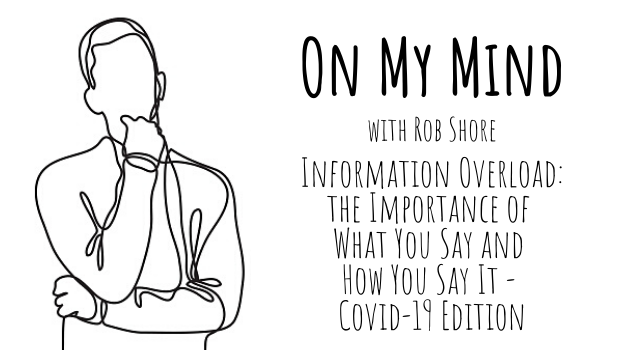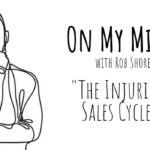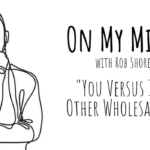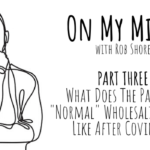Thoughts from Coach Rob Shore about the art, science and lifestyle of wholesaling, for wholesalers and their leaders.
This episode: Information Overload and the Importance of What You Say and How You Say It – Covid-19 Edition
To see all of our Resources To Help You Weather The Coronavirus Storm visit: https://bit.ly/wmm-covid
What’s on your mind? Email me at rob[at]wholesalermasterminds.com
Subscribe at Apple Podcasts or Subscribe via Stitcher or find us on Spotify by searching The New Wholesaler Masterminds Radio Show in your app or wherever you get your favorite podcasts!
On your smart speaker say, “Play The NEW Wholesaler Masterminds Radio Show podcast”.
Transcription
Wholesalers, welcome to On My Mind, my opportunity to tell you what’s on my mind and ask you what’s on yours. Reaching you today from Northern California where we are on lock-down, so I might be churning out more content to help you.
And if I might be honest to help me.
I’d like to talk today about delivery mechanisms and delivery messages and here’s what I’m thinking. As I was watching today, the increased activity of our firms churning out material. Which they should be doing, right? We appreciate our firms churning out material. Material that tells us what the outlook is for the economy material that tells us what’s going to happen in the fixed income marketplace. Material that tells us what’s going to happen in equities. Material that tells us just what the experts are saying about this unprecedented situation. The feed is getting kind of full. I don’t know about you, but my LinkedIn feed is getting kind of full.
There’s a lot of information being generated.
And that’s a good thing, but boy, it becomes a challenging thing when you’re trying to be a wholesaler, trying to reach out.
Now, let’s be clear. That doesn’t mean you shouldn’t be reaching out. You should be reaching out. You should be reaching out to your best advisors. You should be reaching out to your best prospects. You should be reaching out to your centers of influence, but you have to be reaching out, mindful of your delivery mechanism, and your delivery message.
Delivery Mechanism
Let’s make sure that we’re utilizing all of the above. Let’s make sure that we’re using email and using it judiciously, that we’re using snail mail when we can, and people are able to go to their offices. Because in Northern California, you’re not supposed to go to your office, so that wouldn’t necessarily work for a financial advisor. That you’re using video.
Look at something like BombBomb to be able to send personalized videos, use FaceTime, use recorded video wherever possible. To be able to send messages that rise above and away from what is now quickly becoming The Sea of Sameness, in terms of messaging about what’s going on.
It’s information overload. It’s crazy.
One of the tools I want to make sure you know about is LinkedIn Messaging with Voice. LinkedIn messaging where you were able to go into LinkedIn on your iPhone, press a button and leave a voice message for one of your contacts.
Helpful hint here. And I want to make sure you know this because it was my mistake. I didn’t know this. I had sent a colleague in the business, a link to the show that we did about how to do successful virtual meetings. So I sent a voice message to her and I included the link.
She never saw the voice message, only saw the link, thought it was a mass communication message, eg. spam. Well that just sucks, because I also sent that to ten heads of distribution at very large firms. And heaven forbid they only saw the link and thought I was spamming them with just the link and didn’t push the button to listen to the voice recording.
So what’s my message to you? If you’re going to use this mechanism, just include your voice. Don’t include a link. That way it’ll be obvious that you’re supposed to tap there and listen to that. All right, so that’s delivery mechanism.
Change it up.
Let’s be different.
Let’s try to stand out.
Delivery Message
I’m going to underscore something that’s really important here about your delivery message today. A lot of people have been conflicted with should I even be talking about product?
It’s [current events] very day to day and it’s very much the circumstance that you find yourself in relative to your product suite, your advisors, and your firm guidance. But what we know today more than anything is that everybody just needs to be listened to.
Everybody needs to be listened to with empathy.
People just want to know that their voices are heard, and that you care about them.
So let me tell you a personal story about something that happened over the course of the last week that underscores what not to do:
I got an invitation request on LinkedIn, like we all do. Those ones where you just say to yourself, “You know what? I don’t think I should accept this because there is a spam DM coming,” but I took it. I took it because it was somebody in our industry on the insurance side of the business – and wouldn’t you know it?
Sure as shit. As soon as I accepted, within 12 hours, the following message comes:
“Hi Rob. Thanks for connecting. I’m really interested in knowing more about your practice and how we could possibly work together in the future. We have a great new product, with up to 10% bonus and as high as 9% commission. Would you like to chat?”
If there is a textbook case of what not to do, I have just read you the textbook case.
The textbook case of what to do is to reach out to an advisor, perhaps use LinkedIn messaging and simply say,
“Mr. Advisor, Ms. Adviser, I just wanted to reach out, let you know I was thinking about you. I know these times are insanely difficult.
I’ve got a raft of information I’m prepared to share with you regarding your clients, and regarding your practice. When you’re ready to hear it.
In the meantime, I just thought it important to reach out and tell you I’m here if needed.”
That one message alone is very powerful and you can save the product discussion perhaps for another time.
That’s what’s on my mind. Tell me what’s on yours, rob[at]wholesaleramasterminds.com.


 On My Mind: The Injurious Sales Cycle?
On My Mind: The Injurious Sales Cycle? On My Mind: You Versus 183 Other Wholesalers
On My Mind: You Versus 183 Other Wholesalers Exactly What Do Financial Advisors Want From Wholesalers? – Bill Bachrach
Exactly What Do Financial Advisors Want From Wholesalers? – Bill Bachrach On My Mind: Part Three – What Does The Path To “Normal” Wholesaling Look Like After Covid-19?
On My Mind: Part Three – What Does The Path To “Normal” Wholesaling Look Like After Covid-19? Wholesalers, Do You Know the Rules of Highly Effective Networking? with Michael Goldberg
Wholesalers, Do You Know the Rules of Highly Effective Networking? with Michael Goldberg